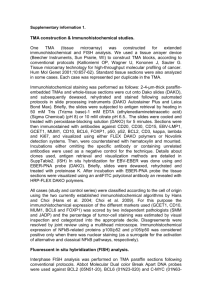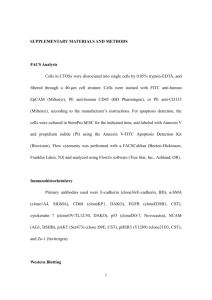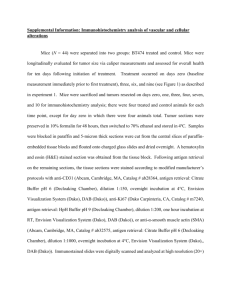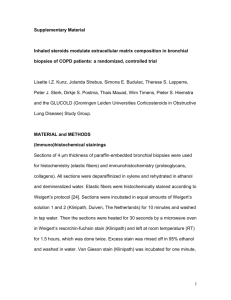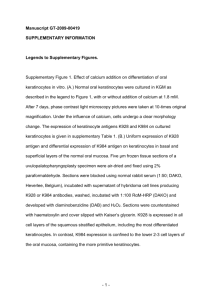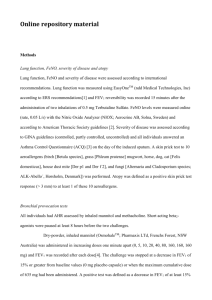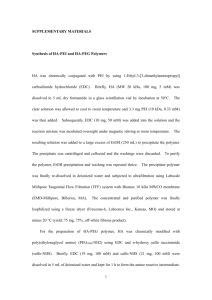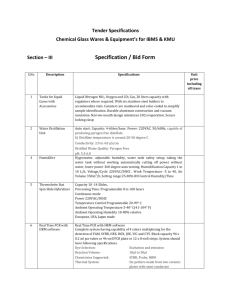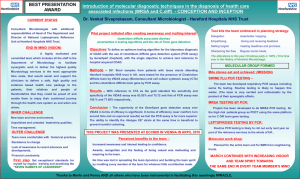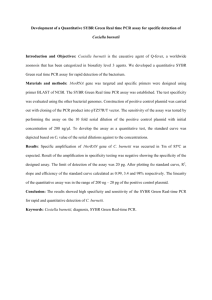Supplementary materials and methods Quantitative reverse
advertisement
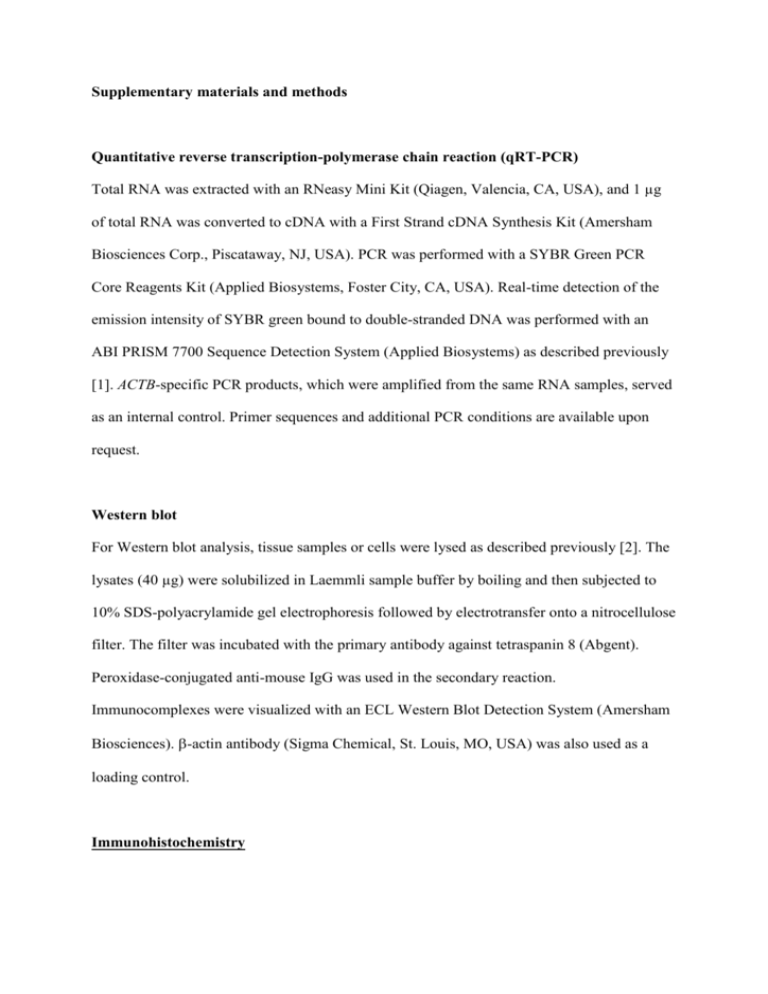
Supplementary materials and methods Quantitative reverse transcription-polymerase chain reaction (qRT-PCR) Total RNA was extracted with an RNeasy Mini Kit (Qiagen, Valencia, CA, USA), and 1 µg of total RNA was converted to cDNA with a First Strand cDNA Synthesis Kit (Amersham Biosciences Corp., Piscataway, NJ, USA). PCR was performed with a SYBR Green PCR Core Reagents Kit (Applied Biosystems, Foster City, CA, USA). Real-time detection of the emission intensity of SYBR green bound to double-stranded DNA was performed with an ABI PRISM 7700 Sequence Detection System (Applied Biosystems) as described previously [1]. ACTB-specific PCR products, which were amplified from the same RNA samples, served as an internal control. Primer sequences and additional PCR conditions are available upon request. Western blot For Western blot analysis, tissue samples or cells were lysed as described previously [2]. The lysates (40 µg) were solubilized in Laemmli sample buffer by boiling and then subjected to 10% SDS-polyacrylamide gel electrophoresis followed by electrotransfer onto a nitrocellulose filter. The filter was incubated with the primary antibody against tetraspanin 8 (Abgent). Peroxidase-conjugated anti-mouse IgG was used in the secondary reaction. Immunocomplexes were visualized with an ECL Western Blot Detection System (Amersham Biosciences). -actin antibody (Sigma Chemical, St. Louis, MO, USA) was also used as a loading control. Immunohistochemistry Immunohistochemical analysis was performed with a Dako Envison+ Mouse Peroxidase Detection System (Dako Cytomation, Carpinteria, CA, USA). Antigen retrieval was performed by heating in Target Retrieval Solution, pH9 (Dako Cytomation) for 40 min at 97˚C. After peroxidase activity was blocked with 3% H2O2-methanol for 10 min, sections were incubated with normal goat serum (Dako Cytomation) for 20 min to block nonspecific antibody binding sites. Sections were incubated with mouse monoclonal anti-tetraspanin 8, 1:50 (Abgent, San Diego, CA, USA) or mouse monoclonal anti-CD31, 1:50 (a marker for endothelial cell, Dako Cytomation) for 1 h at room temperature, followed by incubations with Envision+ anti-mouse peroxidase for 1 h. For color reaction, sections were incubated with DAB Substrate-Chromogen Solution (Dako Cytomation) for 10 min. Sections were counterstained with 0.1% hematoxylin. A result was considered positive if at least 10% of the GC cells were stained. When fewer than 10% of cancer cells were stained, the immunostaining was considered negative. Microvessel counts Microvessel density was assessed by light microscopy in immunohistochemistry-stained areas of tumor containing the highest numbers of capillaries and small venules at the invasive edge. Highly vascularized areas were first identified by scanning tumor sections at low power (40x). The vessel count was determined for three such areas at 400x and the mean of the three counts was calculated. A vessel lumen was not necessary for a structure to be defined as a vessel. RNAi and cell growth, in vitro invasion and wound healing assays To knockdown endogenous TSPAN8, RNAi was performed. Short interfering RNA (siRNA) oligonucleotides for TSPAN8 and a negative control were purchased from Invitrogen (Carlsbad, CA, USA). Two independent oligonucletides were used for TSPAN8 siRNA. Transfection was performed using Lipofectamine RNAiMAX (Invitrogen) as described previously [3]. Briefly, 60 pmol of siRNA and 10 µL of Lipofectamine RNAiMAX were mixed in 1 mL of RMPI medium (10 nmol/L final siRNA concentration). After 20 minutes of incubation, the mixture was added to the cells and then plated on dishes for each assay. Forty-eight hours after transfection, cells were analyzed for all experiments. The cells were seeded at a density of 2,000 cells per well in 96-well plates. Cell growth was monitored after 1, 2, 4 and 8 days by 3-(4,5-dimethylthiazol-2-yl)-2,5-diphenyltetrazolium bromide (MTT) assay [4]. Three independent experiments were carried out. Mean ± SE was calculated for each of the experiments. Modified Boyden chamber assays were performed to examine cell invasiveness. Cells were plated at 10,000 cells per well in RPMI 1640 medium plus 1% serum in the upper chamber of a Transwell Insert (8 µm pore diameter; Chemicon, Temecula, CA, USA) coated with Matrigel. Medium containing 10% serum was added in the bottom chamber. After two days, cells in the upper chamber were removed by scraping, and the cells remaining on the lower surface of the insert were stained with CyQuant GR dye to assess the number of cells. Three independent experiments were carried out. Mean ± SE was calculated for each of the experiments. For the wound healing assay, cells were plated onto fibronectin coated coverslips. The monolayer cells were then scratched manually with a plastic pipette tip, and after being washed with PBS, the wounded monolayers of the cells were allowed to heal for 24 h in RPMI 1640 containing 10% FBS. Statistical methods Correlations between clinicopathologic parameters and tetraspanin 8 protein expression were analyzed by Fisher’s exact test. Kaplan-Meier survival curves were constructed for tetraspanin 8-positive and tetraspanin 8-negative patients. Survival rates were compared between tetraspanin 8-positive and tetraspanin 8-negative groups. Differences between survival curves were tested for statistical significance by log-rank test. Univariate and multivariate Cox regression was used to evaluate the associations between clinical covariates and cancer-specific mortality. SPSS was used to perform these analyses (SPSS Inc., Chicago, IL, USA). Hazard ratio (HR) and 95% confidence interval (CI) were estimated from Cox proportional hazard models. For all analyses, age was treated as a categorical variable (≥ 65 years versus < 65 years). For final multivariable Cox regression models, all variables that were moderately associated (P < 0.10) with cancer-specific mortality were included. A P value of < 0.05 was considered to be statistically significant. 1. Kondo T, Oue N, Yoshida K, Mitani Y, Naka K, Nakayama H, et al. Expression of POT1 is associated with tumor stage and telomere length in gastric carcinoma. Cancer Res. 2004;64:523-9. 2. Yasui W, Ayhan A, Kitadai Y, Nishimura K, Yokozaki H, Ito H, et al. Increased expression of p34cdc2 and its kinase activity in human gastric and colonic carcinomas. Int J Cancer. 1993;53:36-41. 3. Oue N, Naito Y, Hayashi T, Takigahira M, Kawano-Nagatsuma A, Sentani K, et al. Signal peptidase complex 18, encoded by SEC11A, contributes to progression via TGF-alpha secretion in gastric cancer. Oncogene. 2014;33:3918-26. 4. Alley MC, Scudiero DA, Monks A, Hursey ML, Czerwinski MJ, Fine DL, et al. Feasibility of drug screening with panels of human tumor cell lines using a microculture tetrazolium assay. Cancer Res. 1988;48:589-601.
